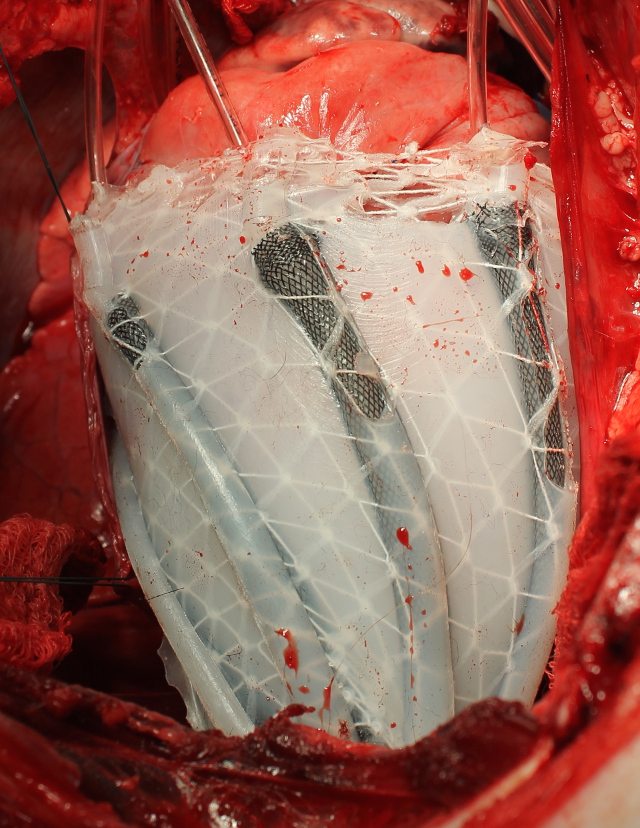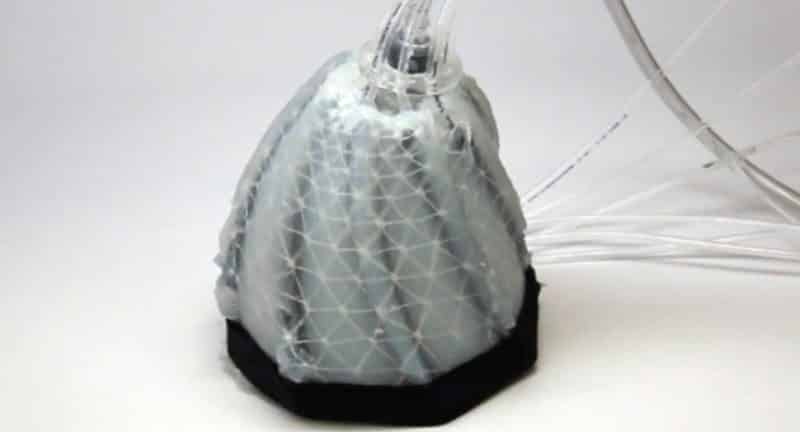Soft Robot Encases Flabby Heart, Helping it Better Pump Blood
More than 5 million Americans and 41 million people worldwide suffer heart failure, a number growing as the population ages. A heart left damaged by a heart attack, high blood pressure or other conditions becomes progressively weaker and unable to pump properly.
Cardiomyopathy is a serious disease of the muscles of the heart, where they become enlarged, flabby, and weak, severely reducing the heart’s ability to pump blood effectively. The heart may also be dilated (stretched out of shape) due to the loss of effective “recoil” contraction after it has relaxed open to accommodate the inflow of blood into its chambers.
This induced inability to contract causes poor pump action and the backup of blood, with some degree of pooling, in the lungs and other vital organs. This lea
ds to accumulation of the fluid in the lungs, liver, kidney, and legs, among other parts. Most patients with dilated cardiomyopathy end up with heart failure. The rhythm of the heartbeat may also be disrupted to a dangerous degree.And now, researchers from Harvard University and Boston Children’s Hospital have developed an innovative robotic sleeve that fits around the heart like a glove, maintaining a steady beat while the patient recovers from the condition.
So far it’s been tested only in animals, improving blood flow in pigs. But this “soft robotic” device mimics the natural movements of a beating heart, a strategy for next-generation treatments of deadly heart failure.
It’s a dramatically different approach than today’s therapies and, if it eventually is proven in people, it might offer a new alternative to heart transplants or maybe even aid in recovery.
“You can customize the function of the assist device to meet the individual needs of that heart,” said Dr. Frank Pigula, a cardiac surgeon who, while at Boston Children’s, took the idea to Harvard colleagues developing soft robotics.
“The nice thing about this is it can go on the outside of the heart, so it doesn’t have to contact blood at all,” said Harvard associate engineering professor Conor Walsh, senior author of the research
“Instead of using a high speed pump to pump the blood back through the circulation, we created these artificial muscles that can be wrapped around the ventricle surface to squeeze the heart from the outside and improve cardiac output that way,” Alazmani, who first came up with the idea for a non-blood-contacting device to control the heart, says. The device was able to synchronize with the native heart motion of the animal it was in.

The international team of researchers says they took inspiration from how the heart works. The silicone sleeve places pneumatic actuators around the heart to mimic the movement of the outer muscle layers. The actuators twist and manipulate the device, so it can control movements on one or both sides of the heart.
The soft robotic sleeve twists and compresses in synch with a beating heart, augmenting cardiovascular functions weakened by heart failure. Unlike currently available devices that assist heart function, Harvard’s soft robotic sleeve does not directly contact blood. This reduces the risk of clotting and eliminates the need for a patient to take potentially dangerous blood thinner medications.
“This research demonstrates that the growing field of soft robotics can be applied to clinical needs and potentially reduce the burden of heart disease and improve the quality of life for patients,” said Ellen T. Roche, the paper’s first author and former PhD student at the Harvard John A. Paulson School of Engineering and Applied Sciences (SEAS) and The Wyss Institute of Biologically Inspired Engineering at Harvard University.
“This work represents an exciting proof of concept result for this soft robot, demonstrating that it can safely interact with soft tissue and lead to improvements in cardiac function. We envision many other future applications where such devices can delivery mechanotherapy both inside and outside of the body,” said Conor Walsh, senior author of the paper and the John L. Loeb Associate Professor of Engineering and Applied Sciences at SEAS and Core Faculty Member at the Wyss Institute.
The sleeve can be customized for each patient, if a patient has more weakness on the left side of the heart, for example, the actuators can be tuned to give more assistance on that side. The pressure of the actuators can also increase or decrease over time, as the patient’s condition evolves.
The sleeve is attached to the heart using a combination of a suction device, sutures, and a gel interface to help with friction between the device and the heart.
In tests, the device worked in pigs, increasing blood volume after a drug-induced cardiac arrest. More research is needed before it can be used on humans, but the early results look promising. “Most people with heart failure do still have some function left,” noted Frank Pigula, in a statement. “One day the robotic sleeve may help their heart work well enough that their quality of life can be restored.”
“The cardiac field had turned away from the idea of developing heart compression instead of blood-pumping VADs due to technological limitations, but now with advancements in soft robotics it’s time to turn back.”
“This research is really significant at the moment because more and more people are surviving heart attacks and ending up with heart failure,” said Roche. “Soft robotic devices are ideally suited to interact with soft tissue and give assistance that can help with augmentation of function, and potentially even be healing and recovery.”































